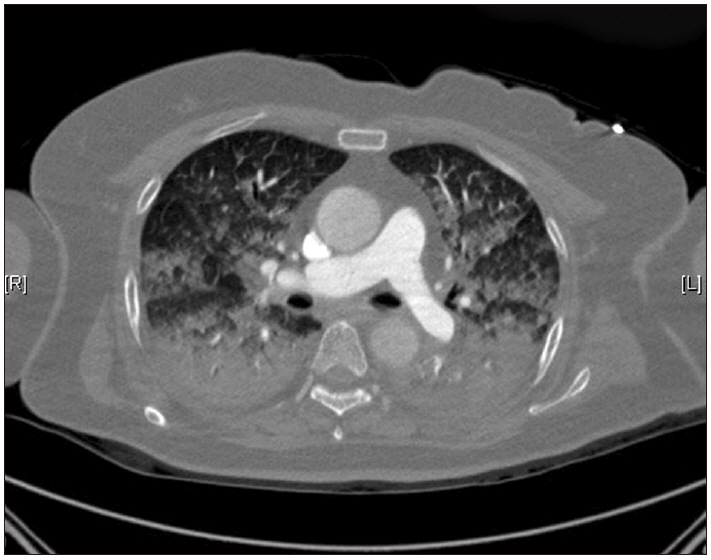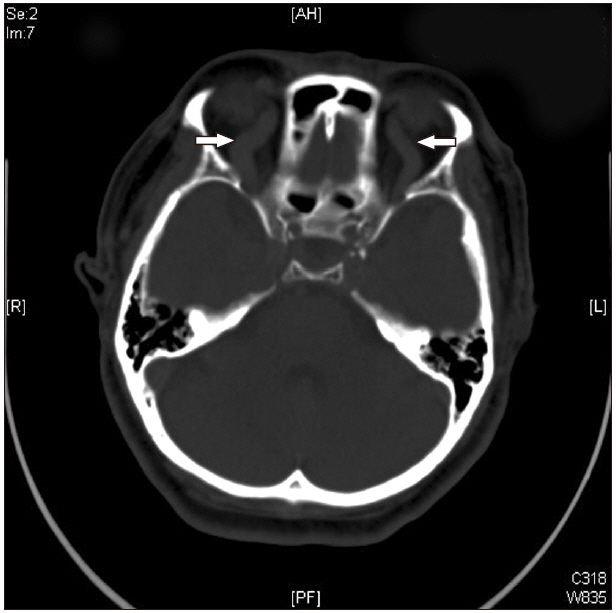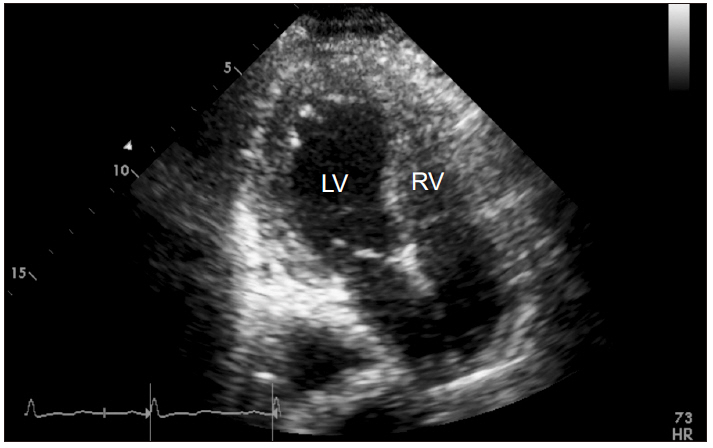Anesth Pain Med.
2020 Jan;15(1):61-65. 10.17085/apm.2020.15.1.61.
Complications of fluid overload during hysteroscopic surgery: cardiomyopathy and epistaxis - A case report -
- Affiliations
-
- 1Department of Anesthesiology and Pain Medicine, Yonsei University Wonju College of Medicine, Wonju, Korea
- KMID: 2500456
- DOI: http://doi.org/10.17085/apm.2020.15.1.61
Abstract
- Background
Hysteroscopic surgery has been used in various gynecological fields. However, massive fluid overload can occur as a complication due to persistent infusion of media for uterine cavity distension. We present the case of a woman who developed cardiomyopathy with pulmonary edema and epistaxis during hysteroscopic surgery. Case: A 76-year-old female underwent hysteroscopic septectomy. She manifested abrupt, active nasal bleeding and regurgitation in the intravenous line. Heart rate, SpO2, and PETCO2 decreased from 55 beats/min to 29 beats/min, from 100% to 56%, and from 31 mmHg to 9 mmHg, respectively. After the operation, brain CT showed bilateral prominent superior ophthalmic vein dilation. Echocardiography showed left ventricle apical ballooning and global hypokinesia. The patient recovered after two days of conservative management, with no sequelae.
Conclusions
Although hysteroscopic surgery is a simple procedure, careful monitoring is necessary to prevent complications from absorption of fluid distending media during the procedure.
Keyword
Figure
Reference
-
Aydeniz B., Gruber IV., Schauf B., Kurek R., Meyer A., Wallwiener D. 2002. A multicenter survey of complications associated with 21,676 operative hysteroscopies. Eur J Obstet Gynecol Reprod Biol. 104:160–4. DOI: 10.1016/S0301-2115(02)00106-9. PMID: 12206931.Bradley LD. 2002. Complications in hysteroscopy: prevention, treatment and legal risk. Curr Opin Obstet Gynecol. 14:409–15. DOI: 10.1097/00001703-200208000-00008. PMID: 12151831.Munro MG., Storz K., Abbott JA., Falcone T., Jacobs VR, et al. AAGL Advancing Minimally Invasive Gynecology Worldwide. 2013. AAGL practice report: practice guidelines for the management of hysteroscopic distending media: (replaces hysteroscopic fluid monitoring guidelines. J Am Assoc Gynecol Laparosc. 2000;7:167-168.). J Minim Invasive Gynecol. 20:137–48. DOI: 10.1016/j.jmig.2012.12.002. PMID: 23465255.Riggs JE. 1989. Neurologic manifestations of fluid and electrolyte disturbances. Neurol Clin. 7:509–23. DOI: 10.1016/S0733-8619(18)30797-7. PMID: 2671634.Istre O., Bjoennes J., Naess R., Hornbaek K., Forman A. 1994. Postoperative cerebral oedema after transcervical endometrial resection and uterine irrigation with 1.5% glycine. Lancet. 344:1187–9. DOI: 10.1016/S0140-6736(94)90507-X. PMID: 7934539.Greyson CR. 2010. The right ventricle and pulmonary circulation: basic concepts. Rev Esp Cardiol. 63:81–95. DOI: 10.1016/s1885-5857(10)70012-8. PMID: 20089229.AbouEzzeddine O., Prasad A. 2010. Apical ballooning syndrome precipitated by hyponatremia. Int J Cardiol. 145:e26–9. DOI: 10.1016/j.ijcard.2008.12.195. PMID: 19195723.Kawano H., Matsumoto Y., Arakawa S., Hayano M., Fijisawa H. 2011. Takotsubo cardiomyopathy in a patient with severe hyponatremia associated with syndrome of inappropriate antidiuretic hormone. Intern Med. 50:727–32. DOI: 10.2169/internalmedicine.50.4795. PMID: 21467706.Kolar F., Cole WC., Ostadal B., Dhalla NS. 1990. Transient inotropic effects of low extracellular sodium in perfused rat heart. Am J Physiol. 259:H712–9. DOI: 10.1152/ajpheart.1990.259.3.H712. PMID: 2396684.
- Full Text Links
- Actions
-
Cited
- CITED
-
- Close
- Share
- Similar articles
-
- Pulmonary edema during hysteroscopic surgery: Three cases report
- Developed hyponatremia during hysteroscopic myomectomy: A case report
- Complications of fluid overload during hysteroscopic surgery
- Pulmonary edema and hyponatremia after hysteroscopic uterine septectomy : A case report
- Dilutional hyponatremia developed during hysteroscopic myomectomy: A case report




